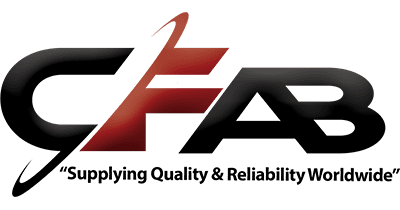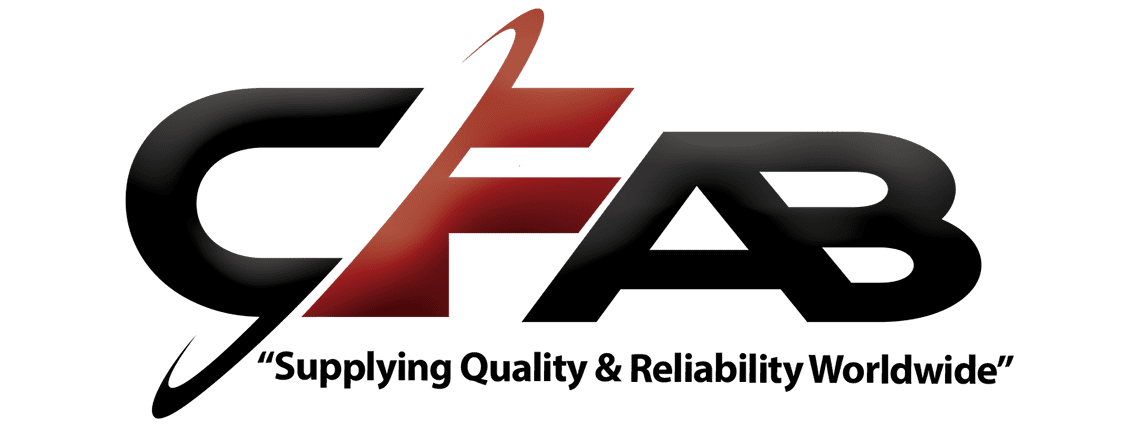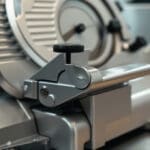Overall equipment effectiveness (OEE) is a fundamental measure for industries striving to optimize manufacturing productivity. It captures a plant’s production success through three vital lenses: Availability, Performance, and Quality. By assessing these areas, OEE offers a comprehensive snapshot of how efficiently and effectively manufacturing processes are functioning.
- Availability evaluates operational uptime by comparing actual production hours to scheduled production hours, addressing issues like equipment breakdowns.
- Performance looks at whether machines operate at peak capacity, identifying losses due to reduced speed or minor halts.
- Quality scrutinizes output, quantifying defect rates, and rework, ensuring only top-quality goods leave the line.
Why is understanding OEE important?
Manufacturers who leverage OEE insights can pinpoint inefficiencies, improve machine utilization, and drive significant productivity gains. Improving OEE can lead to reduced downtime, lower operational costs, and ultimately makes businesses more competitive.
I’m Todd Cleppe, CEO & Co-Founder of CFAB Global. Over the past 25 years, I’ve dedicated my career to advancing manufacturing efficiencies, improving equipment reliability, and implementing innovative solutions in industries like food packaging and industrial mining. With expertise in overall equipment effectiveness, my team and I focus on crafting custom strategies that improve production outcomes for our clients.
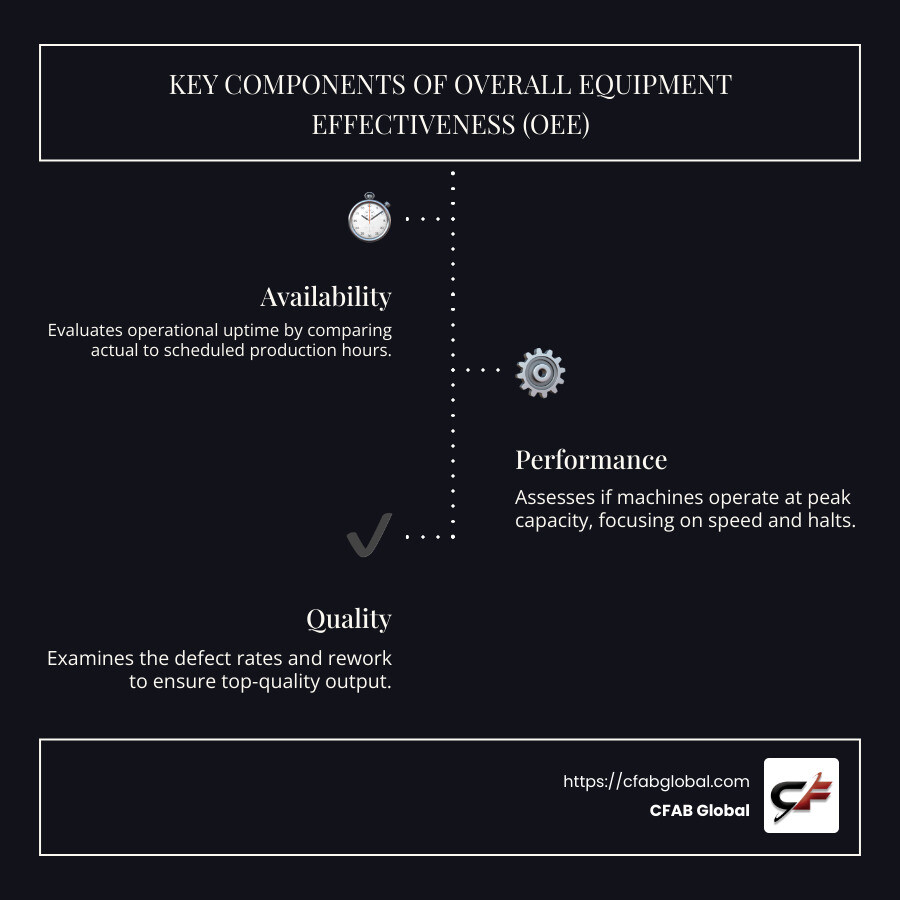
Key terms for overall equipment effectiveness:
– how to calculate efficiency
– key performance metrics for manufacturing
– manufacturing efficiency
Understanding Overall Equipment Effectiveness
To truly grasp overall equipment effectiveness (OEE), break it down into its three core components: Availability, Performance, and Quality. Each of these elements provides a unique perspective on how well a manufacturing operation is functioning.
Availability
Availability measures how often equipment is ready for production when it’s supposed to be. It considers both unplanned stops, like unexpected breakdowns, and planned stops, such as scheduled maintenance or changeovers.
Imagine a machine scheduled to run for 8 hours a day. If it experiences 1 hour of downtime due to a breakdown, the availability for that day is reduced. The goal is to keep these interruptions to a minimum, maximizing the time the equipment is operational. Techniques like preventive maintenance and quick changeover methods (like SMED) can significantly improve availability by reducing both unplanned and planned stops.
Performance
Performance assesses whether the equipment is operating at its maximum potential speed. Losses in performance can occur due to slow cycles or small stops that aren’t significant enough to halt production but still impact efficiency.
Consider a machine that should produce 100 units per hour but only manages 80 due to minor delays. This gap between actual and ideal output highlights performance issues. The ideal cycle time—the fastest time to produce one unit—serves as a benchmark for evaluating performance. Addressing these small inefficiencies through training programs or speed optimization can help close the gap between actual and ideal performance.
Quality
Quality focuses on the output, ensuring that products meet the required standards without the need for rework or generating defects. The good count—the number of units produced without defects—is a critical measure here.
In a perfect scenario, every unit produced is of high quality. However, defects can occur, leading to waste and inefficiencies. Implementing robust quality control measures and defect reduction strategies can help maintain high-quality standards, ensuring that the majority of products are part of the good count.
By understanding and optimizing these three components—Availability, Performance, and Quality—manufacturers can leverage OEE to identify bottlenecks, streamline operations, and improve overall productivity. This holistic approach enables businesses to achieve higher efficiency and remain competitive in their respective industries.
Calculating OEE
Calculating Overall Equipment Effectiveness (OEE) is essential for understanding how well your manufacturing processes are performing. The OEE formula provides a comprehensive view of equipment efficiency by combining three critical components: Availability, Performance, and Quality. Let’s walk through the formula and a real-world example to see how it works.
OEE Formula
The OEE formula is straightforward:
OEE = Availability × Performance × Quality
Each factor represents a different aspect of equipment effectiveness:
- Availability measures the percentage of scheduled time that the equipment is ready for production.
- Performance assesses whether the equipment is running at its maximum potential speed.
- Quality evaluates the proportion of good parts produced, free from defects.
This formula helps identify areas of improvement, allowing manufacturers to focus on reducing downtime, optimizing speed, and enhancing product quality.
Example Calculation
To illustrate how the OEE formula works, let’s consider a practical example. Imagine a factory producing widgets with the following data:
- Scheduled Production Time: 480 minutes
- Unplanned Downtime: 60 minutes
- Total Units Produced: 300
- Defective Units: 30
- Ideal Cycle Time: 1 minute per unit
Step-by-Step Guide
- Calculate Availability:
[
\text{Availability} = \frac{\text{Scheduled Time} – \text{Downtime}}{\text{Scheduled Time}}
]
[
\text{Availability} = \frac{480 – 60}{480} = 0.875 \text{ or } 87.5\%
]
- Calculate Performance:
[
\text{Performance} = \frac{\text{Total Units} \times \text{Ideal Cycle Time}}{\text{Operating Time}}
]
[
\text{Operating Time} = 480 – 60 = 420 \text{ minutes}
]
[
\text{Performance} = \frac{300 \times 1}{420} = 0.714 \text{ or } 71.4\%
]
- Calculate Quality:
[
\text{Quality} = \frac{\text{Good Units}}{\text{Total Units}}
]
[
\text{Good Units} = 300 – 30 = 270
]
[
\text{Quality} = \frac{270}{300} = 0.9 \text{ or } 90\%
]
- Calculate OEE:
[
\text{OEE} = 87.5\% \times 71.4\% \times 90\% = 56.25\%
]
With an OEE of 56.25%, this example shows there is room for improvement in all three areas: availability, performance, and quality.
Benchmarking
Benchmarking your OEE score against industry standards can provide insights into how your operations stack up. Typically, an OEE score of 85% is considered world-class, indicating optimal capacity and productivity. This benchmark helps set targets and drive continuous improvement efforts.
By understanding the OEE formula and using real-world data, manufacturers can pinpoint inefficiencies, implement targeted strategies, and ultimately boost productivity and profitability.
Strategies to Improve OEE
Improving Overall Equipment Effectiveness (OEE) is not a one-time task but an ongoing journey. Let’s explore some key strategies to improve OEE through continuous improvement, data-driven decision-making, and employee engagement.
Measure and Track OEE
Start by establishing a baseline for your equipment’s OEE. This initial measurement is crucial as it serves as a reference point for future improvements. Set clear targets for your OEE score and regularly monitor progress. This ongoing tracking allows you to identify trends, pinpoint issues, and make informed decisions.
Focus on Availability
Availability, the first pillar of OEE, hinges on minimizing downtime. Implement preventive maintenance programs to reduce unexpected breakdowns. This approach ensures that maintenance activities are planned and executed during scheduled stops, preventing disruptions. Additionally, optimize changeover processes to minimize setup times, enhancing equipment availability and utilization.
Improve Performance
Performance improvement involves optimizing the speed at which equipment operates. Identify and address factors causing speed losses, such as slow cycles and small stops. Implement training programs to equip operators with the skills needed to run equipment efficiently. Speed optimization not only boosts performance but also contributes to higher overall productivity.
Improve Quality
Quality is critical to achieving high OEE. Focus on defect reduction by implementing robust quality control measures. Conduct regular inspections and root cause analyses to identify sources of defects. Accept technologies like computer vision to detect anomalies in real-time, ensuring consistent product quality. By reducing rework and scrap, you can significantly improve your OEE score.
By adopting these strategies, manufacturers can foster a culture of continuous improvement, leveraging data-driven insights and engaging employees at all levels. This approach not only improves OEE but also drives operational excellence and profitability.
Frequently Asked Questions about Overall Equipment Effectiveness
How do you calculate overall equipment effectiveness?
Calculating Overall Equipment Effectiveness (OEE) is straightforward once you understand its three key components: availability, performance, and quality. The formula is:
OEE = Availability x Performance x Quality
Each component is a percentage, and when multiplied together, they give you the OEE score. This score represents the percentage of manufacturing time that is truly productive.
Availability measures the percentage of scheduled time that the equipment is available to operate, taking into account unplanned and planned stops. Performance assesses how fast the equipment runs compared to its designed speed, considering slow cycles and small stops. Quality calculates the rate of good units produced versus the total units started, focusing on defect reduction.
To illustrate, if a machine is available 90% of the time, performs at 95% speed, and produces 98% quality output, the OEE would be:
OEE = 0.90 x 0.95 x 0.98 = 0.8379 or 83.79%
This score indicates the overall efficiency of the equipment in the production process.
What does 85% OEE mean?
An OEE score of 85% is often considered a benchmark for world-class performance. It implies that the equipment is operating at optimal capacity, balancing availability, performance, and quality effectively. Achieving 85% OEE means that the equipment is highly productive, with minimal downtime, efficient production speeds, and low defect rates.
This benchmark is a target for many industries, indicating strong productivity and efficient use of resources. Reaching this level requires continuous monitoring and improvement of processes, ensuring that equipment operates at its best.
What are the three components of OEE?
The three components of Overall Equipment Effectiveness are:
-
Availability: This measures the percentage of scheduled production time that the equipment is available and ready to operate. It accounts for both planned stops, like scheduled maintenance, and unplanned stops, such as breakdowns.
-
Performance: This evaluates the speed at which the equipment runs compared to its maximum possible speed. It considers any slow cycles or small stops that may reduce efficiency.
-
Quality: This assesses the proportion of good parts produced without defects. It focuses on minimizing rework and scrap to ensure that the output meets quality standards.
Together, these components provide a comprehensive view of equipment productivity and highlight areas for improvement. By focusing on these elements, businesses can improve their operational efficiency and competitiveness.
Conclusion
At CFAB Global, we understand that achieving excellence in manufacturing is not just about having the right equipment—it’s about maximizing its effectiveness. This is where Overall Equipment Effectiveness (OEE) becomes a game-changer. Our commitment to driving productivity and efficiency is embodied in our flagship offering: the Machine Reliability Program.
CFAB Global: Your Partner in Efficiency
Located in Chelsea, Iowa, CFAB Global is a trusted leader in providing advanced machinery solutions and support. We cater to a wide range of industries, including manufacturing, construction, agriculture, and energy. Our expertise and dedication ensure that your machinery not only meets but exceeds operational demands.
The Machine Reliability Program
Our Machine Reliability Program is at the heart of what we do. It’s not a one-size-fits-all solution but a custom strategy that fits your unique needs. By focusing on the core aspects of availability, performance, and quality, we help businesses achieve maximum productivity, reduce costly downtime, and extend the lifespan of critical machinery components.
Through personalized analysis and cutting-edge services, we ensure your equipment operates at peak performance. Whether it’s implementing preventive maintenance to boost availability or optimizing performance through training programs, our approach is comprehensive and effective.
Industry Expertise
CFAB Global boasts a proven track record across diverse industries. In manufacturing, we streamline production processes and improve machinery performance. In agriculture, our custom services boost efficiency and extend machinery life. Our expertise in the energy sector ensures machinery runs smoothly, reducing potential downtime.
Our team of specialists brings years of industry experience, offering the highest level of support. We focus on predictive maintenance strategies that prevent breakdowns before they occur, helping you maximize your return on investment.
For reliable machinery solutions that drive productivity and efficiency, CFAB Global is your go-to partner. Explore our reliability solutions to see how we can help your business thrive.
In conclusion, Overall Equipment Effectiveness is more than just a metric—it’s a pathway to operational excellence. With CFAB Global by your side, you can harness the full power of OEE to achieve world-class performance and stay ahead in today’s competitive landscape.
